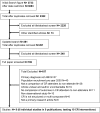The effectiveness of modern cardiac rehabilitation: A systematic review of recent observational studies in non-attenders versus attenders
- PMID: 28498869
- PMCID: PMC5428953
- DOI: 10.1371/journal.pone.0177658
The effectiveness of modern cardiac rehabilitation: A systematic review of recent observational studies in non-attenders versus attenders
Abstract
Background: The beneficial effects of cardiac rehabilitation (CR) have been challenged in recent years and there is now a need to investigate whether current CR programmes, delivered in the context of modern cardiology, still benefit patients.
Methods: A systematic review of non-randomised controlled studies was conducted. Electronic searches of Medline, Embase, CINAHL, science citation index (web of science), CIRRIE and Open Grey were undertaken. Non-randomised studies investigating the effects of CR were included when recruitment occurred from the year 2000 onwards in accordance with significant CR guidance changes from the late 1990's. Adult patients diagnosed with acute myocardial infarction (AMI) were included. Non-English articles were considered. Two reviewers independently screened articles according to pre-defined selection criteria as reported in the PROSPERO database (CRD42015024021).
Results: Out of 2,656 articles, 8 studies involving 9,836 AMI patients were included. Studies were conducted in 6 countries. CR was found to reduce the risk of all-cause and cardiac-related mortality and improve Health-Related Quality of Life (HRQOL) significantly in at least one domain. The benefits of CR in terms of recurrent MI were inconsistent and no significant effects were found regarding re-vascularisation or re-hospitalisation following AMI.
Conclusion: Recent observational evidence draws different conclusions to the most current reviews of trial data with respect to total mortality and re-hospitalisation, questioning the representativeness of historic data in the modern cardiological era. Future work should seek to clarify which patient and service level factors determine the likelihood of achieving improved all-cause and cardiac mortality and reduced hospital re-admissions.
Conflict of interest statement
Figures
References
-
- World Health Organisation. Cardiovascular Diseases Factsheet 317 WHO, 2015.
-
- British Heart Foundation. Cardiovascular Disease Statistics. UK: BHF, 2016.
-
- NICE. Cardiac Rehabilitation Services Commissioning Guide 40. UK: NICE, 2011.
-
- Piepoli MF, Corra U, Adamopoulos S, Benzer W, Bjarnason-Wehrens B, Cupples M, et al. Secondary prevention in the clinical management of patients with cardiovascular diseases. Core components, standards and outcome measures for referral and delivery: A Policy Statement from the Cardiac Rehabilitation Section of the European Association for Cardiovascular Prevention & Rehabilitation. Endorsed by the Committee for Practice Guidelines of the European Society of Cardiology. Eur J Prev Cardiol. 21 (2012)664–81. 10.1177/2047487312449597 - DOI - PubMed
-
- BACPR. The BACPR standards and core components for cardiovascular disease prevention and rehabilitation. UK: BACPR, 2012. - PubMed
Publication types
MeSH terms
LinkOut - more resources
Full Text Sources
Other Literature Sources
Medical







